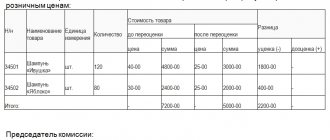The main beauty of the assessment
In order to better understand why they eat this, I will next tell you about the key goals and objectives when evaluating personnel:
- Audit. Identify the strengths and weaknesses of employees and use them for the benefit of the company;
- Education. Form a plan for the training and comprehensive development of everyone in the team;
- Promotion. Create adequate conditions and criteria for career advancement;
- Feedback. Receive continuous feedback from employees about the quality and conditions of their work.
And the audit will also help determine the current state of your company and formulate a plan for its development. In addition, if you systematically evaluate personnel and take into account the goals of personnel evaluation, then development will become constant.
Development! How amazing!
personnel performance characteristics
We will talk about the characteristics that affect the results of personnel work. This means we will take into account:
- Competencies;
- Knowledge;
- Skills;
- Behavior;
- Personality characteristics.
What is important? Take into account the specifics of the organization and the position of the employee being assessed. Next I will tell you with examples.
Example 1. When assessing ordinary employees, first of all you need to pay attention to performance characteristics: knowledge of their area of work, speed and accuracy in performing assigned tasks.
Example 2. When assessing managers, along with competence, personal qualities are also considered: the ability to make decisions and take responsibility, the ability to achieve results from subordinates, leadership qualities, etc.
Basic
Now you understand that different personnel need to be assessed differently. Now I will give the two most common groups of criteria.
1.1 Competence
That is, the knowledge, skills and abilities of the employee. At the same time, as I said above, much will depend on the position of the specialist in the company.
Often, not only knowledge and skills are assessed, but also personal characteristics that are important for the position held. The best way to assess competence is by simulating solutions to real work cases and problems.
1.2 Efficiency
In other words, the result of the work. Comparative characteristics are used: are tasks completed on time and to the extent planned, which employee is able to solve a similar volume of tasks faster, etc.
In this group of criteria, it is important to take into account point A and point B. That is, it is best to first determine target indicators, and after a certain period of time compare plan and fact.
Additional
In addition to this general division, four groups of criteria can be distinguished, which we have already mentioned in one way or another in the examples above:
- Professional. That which is directly related to the performance of the duties of a specialist, all the experience, knowledge and skills that he applies in the process of work;
- Business. Analysis of how punctual, responsible, and organized the employee is. We can call this group of criteria an approach and attitude to work;
- Psychological. Personal characteristics of a person, his characteristics: resistance to stress, ability to multitask, etc.;
- Specific. These characteristics further emphasize the individual characteristics of the employee, his state of health, and the attitude of his colleagues towards him.
Only you yourself can determine which personnel assessment indicators will become decisive for you: according to professional criteria or psychological ones, according to competence or efficiency.
There are no universal tips here. Everything comes from the priorities of your organization.
How many different criteria
https://youtu.be/7SFDorsKuwQ
Who can be assessed?
An assessment of suitability for a position in terms of existing qualifications and potential can be carried out in relation to any employee of the company, depending on the tasks assigned to the personnel commission.
In particular, the qualification level can be determined for:
- line managers for not only the performance of immediate duties, but also the ability to manage the department and solve assigned tasks as a whole;
- an individual employee to identify his abilities and suitability for the position;
- groups of workers with the same qualifications in anticipation of staffing optimization.
What are the main objectives of business personnel assessment? How to organize a manager's working time? Find out here.
Assessment methods
The evaluation criteria are clear. But in order to use them, let's define those personnel assessment tools or methods that will help to identify, count and generally evaluate them in some way.
By the way, these methods were developed both within Russian companies and on the basis of foreign experience in personnel assessment.
Quantitative
Those that allow you to count everything you can. They are considered the most objective.
Simple classification
Ranking employees from best to worst for a specific indicator. Used to solve a specific narrow issue.
Also, simple classification is used in combination with other methods.
Example: to identify a leader in the sales department, you simply need to rank all managers by the number of sales per month or the amount of revenue. This can be either an annual staff assessment or a quarterly review.
KPI method
Perhaps the most basic method of personnel assessment. And here is its essence: at the beginning of the month, certain tasks are formed for the specialist, which, as a percentage, form the final result and his salary, respectively.
And at the end of the month, the percentage of completion of all tasks is calculated, which ultimately forms the employee’s income.
On topic: KPI: 17 examples + formulas
Example: for 100% implementation of the plan, an Internet marketer will be paid 50,000 rubles. The following tasks for the month:
| Index | Plan | Fact | Indicator weight | Completion percentage |
| Unique site visitors | 1 000 | 1 000 | 25% | 25% |
| Post reaching 500 people | 15 | 10 | 30% | 20% |
| Applications from the site | 30 | 20 | 45% | 30% |
In total, the plan is 75% completed, and our marketer will receive 50,000 x 0.75 = 37,500 rubles
Rating system
Conducting a personnel assessment using this method is as follows: for each completed task, a specialist receives a certain, previously designated number of points.
And based on the results of the period, say, a month, a staff rating is formed based on the points earned.
Example: for each finished part, the machine operator receives 10 points. At the end of the month, the points are added up and we get the most productive employee.
Rank method
Top management compiles something like a personal rating for everyone in the team or department.
After which, all generated ratings are compared with each other, and those employees who are in the last positions in most ratings can be transferred to less highly paid positions, that is, become lower in rank.
Example: you have 8 seamstresses in your workshop for sewing children’s clothing. The head of the company, the head of the workshop and the senior seamstress make ratings based on the annual assessment of personnel (each independently!) and compare them.
It turns out that seamstress No. 2 and seamstress No. 7 were in last positions on all three lists. Then they can be transferred to seamstress assistants, reduce the volume of orders, or send them for additional training, transferring them to the rank of trainees.
There are so many methods, they all need to be used!
Quality
These are more complete descriptive characteristics of personnel. Often the description occurs in free form. Below I have prepared the main approaches to assessing the personnel of this group.
Questioning
The simplest qualitative research method is suitable for assessing personnel during recruitment.
Classic questions for this kind of survey: work experience, position sought, desired salary, priorities in choosing a job (salary, team, self-development, proximity to home, etc.), key skills.
Example: You need to evaluate two employees applying for the same position - beauty salon administrator.
- Candidate 1. Without experience, looking for an administrator position, wants the level of pay that you are ready to offer, but for a candidate with experience. The priority in choosing a job is proximity to home and salary level;
- Candidate 2. Has 2 years of work experience, is looking for a position with the possibility of career growth to the manager of a salon or several, resigned from a similar position due to lack of prospects.
And you, in turn, plan to change from one beauty salon to a network of salons by the end of the year. Who do you choose? Obviously, candidate 2. This simple method will allow you to evaluate the candidate when hiring.
Descriptive assessment
A simple narrative description of an employee's strengths and weaknesses is often used in conjunction with other methods to provide the most complete assessment.
The description will allow you to choose appropriate methods of encouragement, avoid conflict situations in the team and make the right management decisions.
Example: description of the profile of a staff accountant. Key competencies: more than 5 years of experience as an accountant in a company without any complaints.
Strengths: competent, punctual, attentive, active, able to argue her point of view, offers her own solutions to problems.
Weaknesses: assertive, difficult to accept criticism, not comfortable working in a team.
Matrix method
For each position, a so-called “ideal matrix” is formed, that is, a set of characteristics in percentage terms. After which a similar matrix is compiled for the employee already working in this position.
The two matrices are compared and then a conclusion is made about the employee’s suitability for a specific position. The method is good for assessing personnel during hiring.
Example: You are looking for a full-time designer. His exaggerated ideal portrait and portraits of candidates look like this:
| Competencies | “The Ideal Matrix” | Candidate – Anastasia | Candidate – Olga |
| Knowledge of Photoshop and Adobe Illustrator programs | 50% | 25% | 50% |
| Meeting deadlines for completing tasks | 20% | 40% | 10% |
| Communication skills | 15% | 10% | 25% |
| Experience in similar work | 15% | 25% | 15% |
Who will you hire? That's right, Olga. Because despite the high degree of responsibility and extensive experience working with Anastasia, Olga more closely matches your “ideal matrix” of a designer.
360 degrees
Within the framework of this method, the employee’s work is assessed by himself, his colleagues, supervisor, clients, partners or contractors with whom he interacts.
The result is the most complete picture with an understanding of growth points in the specialist’s work.
Example: colleagues, in connection with the annual personnel assessment, evaluate the employee - consultant of the toy store Vladimir, as a specialist with excellent knowledge of the assortment.
If they don’t know something about a particular toy, they will ask Vladimir, and he will definitely help.
The manager evaluates Vladimir as an executive and responsible employee who sometimes performs even those tasks that are typical for a store administrator, and not for an ordinary consultant.
Clients also speak well of Vladimir. What they appreciate about him is that he doesn’t just strive to sell a toy at a higher price, but first finds out all the child’s preferences and recommends the most suitable options in different price categories.
So, thanks to the 360-degree assessment method, we see that Vladimir has every chance of getting promoted to store administrator or senior consultant.
Group discussion
Conducting personnel assessments using this method is similar to the previous one. But the larger discussion involves the manager, the employee and, if possible, a guest expert in the field of the position being discussed.
An expert is needed for an objective, expert assessment of personnel. This method is suitable for assessing a specialist’s qualifications and identifying his attitude to work.
As part of such a discussion, you can give specific case studies to determine how an employee would behave in a similar situation.
Example: for a specialist in the logistics department: You sent a car with urgent cargo to the customer, and the driver of the car got into an accident. Your actions.
To which the employee replies that first he will find out how serious the accident occurred. Based on this, he will estimate the delivery delay time. He will contact the customer, explain the situation, and agree on a time delay. Apologizes for the inconvenience caused.
Then he will contact the driver of another car, whose route passes close to the accident site, and offer him to deliver the cargo.
From this answer you understand that the employee is responsible for his work and interacts competently with the client, looking for rational solutions without panicking.
How amazing! I will definitely try to evaluate my staff using these methods.
Combined
That is, the interaction of descriptive and quantitative methods. So, let’s look at personnel assessment tools.
Critical Situation Certification
In the company, for each employee, “correct” and “incorrect” behavior is formed in typical work situations or cases (for example, in accordance with the job description).
Next, the observer evaluates the behavior of the staff on a 5- or 10-point scale in those very “decisive” situations.
After summing up the points for solving cases within a specific period, a rating of employees is formed.
Example: for call center employees, every successful resolution of a conflict situation with a client. Where successful = the client is satisfied, does not hold a grudge against the company, is 10 points in the rating.
The method will allow you to digitize quality characteristics. Based on the results of a given period, a rating of employees is compiled, from which it is clear who most often demonstrates the “correct” behavior in resolving conflict situations.
You can assign a bonus to such a rating leader or offer training to his colleagues in communicating with a client in a stressful situation.
Scaling method
As part of the method, a list of skills, qualities, and characteristics required for the position is formed. Each item in the list is assigned a value:
- "Great";
- "Fine";
- "Satisfactorily";
- "Badly".
Or vice versa, the characteristics of a particular specialist are written down and compared with the requirements for the position on a scale:
- “Far beyond requirements”;
- “Exceeds requirements”;
- “Meets requirements”;
- “Meets some requirements”;
- “Does not meet requirements.”
This way you can assess how well this employee fits the position he or she occupies.
Example: for a hairdresser-trainee:
- Qualification – “exceeds requirements”;
- Attitude towards clients – “meet the requirements”;
- The attitude towards work is “meet the requirements”.
From which you can conclude that it is time to promote this employee from a trainee to a full-fledged hairdresser.
Grouping
Dividing the entire team into groups based on the principle of work efficiency, from those who work unsatisfactorily to those who work without complaints.
This method allows you to evaluate the effectiveness of the team as a whole. Identify areas of growth and raise the question of what to do with a group of employees whose results are low.
Please note that if you are not satisfied with the work of even a third of your employees, this is a reason to reconsider their motivation, as well as the system of professional development in the company.
Example: your company has three departments: project management – 3 people, sales – 5 people, administration – 2 people.
At the same time, 1 manager, 2 managers and 1 ACS specialist work well. The rest of the sales department employees regularly do not fulfill the plan, managers do not meet project deadlines, and the AXO specialist has budget shortfalls.
Only 40% of employees work effectively in your company.
That is, you need to review the employee motivation system (by the way, one of the motivation methods is in the video below), determine rewards and fines, and organize a system for staff development.
https://youtu.be/XH_Pn6AK1fY
System elements
Considering that employees perform different duties, are involved in different departments, and also belong to different categories of personnel, the use of the same evaluation criteria is not advisable, and therefore the evaluation system should provide an integrated approach that allows analyzing the performance of employees both individually and in general for the enterprise.
In particular, the components of the system should include the following criteria:
- qualification;
- effectiveness;
- quality;
- certain skills;
- motivation.
How is personnel assessment carried out in an organization?
As a rule, personnel assessment is carried out on the basis of a local act, which is the Regulations on Personnel Assessment, and an approved schedule, to which a list of employees is attached.
There are personnel changes ahead and it is necessary to assess the labor productivity of certain employees; the selection criterion will be performance; if the goal is to strengthen control, the assessment will be made for the entire staff in the form of a certain system, taking into account all derivatives of labor relations from personal characteristics to existing skills and aspirations .
As a rule, personnel assessment is carried out using the following methods:
- biographical;
- written characteristics;
- assessing performance based on certain types of tasks;
- group discussion;
- comparison of the matrix vision with a real set of qualifications and personal characteristics;
- self-esteem.
Assessment is carried out in the following forms:
- oral questioning or interview;
- through tests;
- certification in the form of a score sheet.
But the assessment process itself can be carried out through the use of the following technologies:
- annual assessment, for example, the same certification;
- express assessment, which is based on a quick assessment of just a few criteria necessary to complete a specific task.
Step-by-step instruction
All this is good, just wonderful, you say. But how to apply it? Let's take a step-by-step look at how to conduct a staff assessment.
Step 1. Description of functions
So, the personnel assessment procedure begins with the functions of the employee. This is the starting point for understanding how well it meets the requirements, objectives and interests of the company. It can be issued in the form of a job description.
Detailed example:
Let's look at the example of a sales manager already working for you. According to the instructions, the responsibilities of a sales manager include:
- Search for clients;
- Reception and processing of incoming applications;
- Drawing up and concluding contracts;
- Transfer of the paying client to a technical specialist;
- Receiving feedback from the client.
Step 2: Define Requirements
After the functions have been formed and before proceeding directly to the question of “how to conduct a personnel assessment,” you need to determine certain indicators, be they quantitative or qualitative.
Based on these indicators, you can understand how well the employee performs the functions specified above. A prerequisite for the assessment is to communicate to the employee both his functions and the indicators for these functions.
Detailed example:
Let’s say for our manager these numbers will look like this, in order:
- Search for clients – 10 new clients per month;
- Reception and processing of incoming applications - 50% of incoming requests;
- Drawing up and concluding contracts – number of correctly executed ones = number of sales;
- Transfer of a paying client to a technical specialist – 100% of paying clients;
- Receiving feedback from the client - at least 70% of surveyed clients.
It would be great if at this step, before introducing scheduled certification, you conduct the first certification of the employee to determine his incoming indicators, that is, what results he has now according to the criteria you have identified.
Step 3: Quantitative Analysis
For an example of quantitative analysis, let's take KPI, since this is one of the main methods of personnel assessment, and determine the planned indicators. Next, you should tell your manager about these planned indicators.
It should also be explained that a planned automatic assessment will be carried out based on these quantitative indicators, and salary calculations will be carried out according to kpi, in accordance with the above indicators.
Detailed example:
Let’s say that each of the responsibilities (I wrote about them above) has a weight in the KPI of 20%.
It will be easier to track EPR indicators using a CRM system (for example, Bitrix 24 or Megaplan), where you can see the number of new clients, new contracts and sales, information about customer ratings of services and the presence or absence of missed calls.
By the way. If you decide to use Megaplan, then I have prepared a promotional code “Megastart” especially for you. It gives a 10% discount + another 14 days of free period. Just tell it to a specialist -> megaplan.ru
Step 4. Descriptive analysis
At this moment, not only quantitative indicators come into force, but also the qualitative characteristics of the specialist and the individual.
What will be your priority, qualitative or quantitative indicators, is up to you to decide. But remember, there is no such profession as “good person”!
Detailed example:
We continue to evaluate our manager. To do this, we apply the “360 degree” method.
We will interview the second department manager, the head of the company and the head of the department, several current clients, as well as technical specialists who receive a paying client from the manager to provide the service.
Step 5. Formation of an overall assessment
It is at this moment that you need to decide what is more important, quantity or quality.
Don’t forget about combined assessment methods, which in this case will come to your aid and allow you to form a complete understanding of the level of effectiveness of a particular employee.
Detailed example:
We calculate quantitative indicators based on kpi, and also obtain a general description of the employee’s qualities using the “360 degree” method.
KPI method:
- Search for clients – 6 per month;
- Reception and processing of incoming applications - 30% of requests;
- Drawing up and concluding contracts – number of correctly executed ones = number per month;
- Transfer of a paying client to a technical specialist – 100% of paying clients;
- Receiving feedback from the client based on the results of the service provided – 40% of respondents.
“360” method:
- Gets lost in conflict situations;
- Polite;
- He jokes a lot.
Step 6. Comparison with the standard
As mentioned above, in addition to assessing a specific employee, your understanding should always be what his level of effectiveness should ideally be.
At this stage, you compare the specialist’s assessment with that ideal. The matrix evaluation method will help us here. In terms of quantitative indicators, we have an “ideal” or plan.
Detailed example:
Let’s compare the niche “ideal” matrix with the matrix of a sales manager. By the way, to compile it we took into account the results of the “360 degrees” method.
| Criteria | "Ideal" | Manager's assessment |
| Ability to reasonably resolve controversial issues | 50% | 30% |
| Politeness | 30% | 30% |
| Sense of humor | 20% | 40% |
Step 7. Final assessment
When the entire complex of assessment activities has been completed, and you have data on how it is, how it should be and how strong the gap is between these two concepts, you can conduct an audit of the assessment and correctly characterize the employee.
Detailed example:
Based on the results of the assessment audit of the same manager, we received the following indicators:
- By kpi. 75.4% of the plan was fulfilled;
- According to the matrix. There is a 20% discrepancy on two points.
Step 8. Next steps
The resulting assessment simply needs to be communicated to the employee. Discuss with him what he thinks about the result obtained and come to further steps.
Perhaps the result will be a task to improve qualifications, a change of position, or a list of growth points.
Because performance analysis alone will not bring growth. It is needed only in order to formulate the right action plan to improve the situation.
Detailed example:
We find out from our manager what prevented us from fulfilling the plan 100% and identify growth points, for example:
- Use new channels to find clients;
- Automate receiving feedback;
- Take an online course on argumentation theory.
After which we obtain the manager’s consent to these measures and determine the time frame for implementation, and also do not forget about control. Only in this way will all the previously completed 6 steps give tangible results.
WE ARE ALREADY MORE THAN 32,000 people. TURN ON
In-scale / marketing
Factors influencing the rating
The list of such factors is long. Because there was no section in my article where I would not encourage you to take into account the situation, circumstances and characteristics of a particular employee when assessing.
For convenience, we can highlight several main factors that have a greater influence on personnel assessment:
- Biological. Age and gender characteristics, mental and physical abilities, influence of weather and climatic conditions;
- Socio-economic. Labor legislation, degree of protection, level of remuneration;
- Organizational. Working conditions in the company, the tasks that are set for the employee, the resources that are available to him to solve these problems;
- Market. Unemployment level, market demand for specialists of a similar position, market saturation with these specialists or their shortage;
- Psychological. The moral state of the employee, his attitude towards work, relationships in the team. And also a sense of his own importance and belonging.
Interesting. 41% of employees (according to surveys of the largest HR portal in Russia) are ready to change jobs if they are offered a more interesting project.
It must be remembered that all these main factors of personnel assessment affect the employee in a complex manner.
Examples
As an example of conducting a comprehensive assessment of personnel at an enterprise or organization, the following cases can be cited.
1. The HR department is tasked with assessing employees on their intellectual level, diligence, communication skills, desire for self-development, stress resistance and non-conflict. These qualities are important for effective and successful work. To systematically assess such a large set of characteristics, complex methods were chosen, including psychological testing, competency interviews, training exercises on communication skills and a “360 degree” assessment.
2. The distribution company assessed the professionally significant personal qualities of managers working with clients. It is necessary to evaluate achievement orientation, organizational skills, charisma, and the ability to competently express one’s thoughts to the public. A set of tools for assessing such characteristics was selected as follows: self-presentation, business case, psychological testing.
3. To assess the leadership qualities of personnel at a large industrial enterprise, an assessment of the most promising employees was carried out. For this purpose, a third-party expert organization was invited, which proposed the following set of assessment tools: interviews, psychological testing, written business exercises, role-playing games.
underwater rocks
As in any process, there are certain problems in introducing a personnel assessment system:
- Wrong choice of personnel assessment methodology. A “one-sided” approach when evaluating personnel is the most common mistake;
- Certification is divorced from employee motivation. As a result, he simply does not understand why certification is needed if it does not in any way affect the current state of affairs;
- High degree of subjectivity. Determine for yourself how to avoid this, whether third-party specialists will be involved in expert assessment of personnel;
- Inaction. After assessing the current situation, next steps should be formed based on the results obtained.
I recommend introducing assessment into the company’s work and monitoring indicators on an ongoing basis. Since one-time events will only cause resistance and additional problems in personnel assessment.
Principles
The basis for personnel assessment is several principles:
- the subject of assessment, namely the assessment of the result obtained for a certain period;
- confidentiality of the result, which must be ensured by persons allowed to conduct the assessment;
- feedback, which involves familiarizing the tested employee with the results obtained;
- objectivity achieved by assessing several criteria;
- the validity of the assessment, confirmed by documented data;
- frequency, namely, the presence of approved schedules, reasons for carrying out and basic requirements.
In fact, any organization is a system consisting of individual divisions, areas of activity and principles for achieving its goals.
For example, one department may have 7 employees, and another 10, while labor productivity and indicators may be higher in a department with fewer employees due to higher qualifications of employees, a competent department head and rational use of the funds received to achieve the goal.
Accordingly, based on the results of the assessment, through personnel changes and other methods, it is possible to achieve greater productivity and increase profitability.
You will find methods for business assessment of personnel in our article.
Personnel evaluation criteria - what is it? See here.







